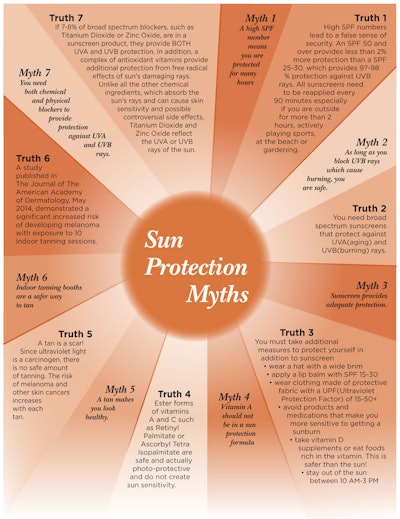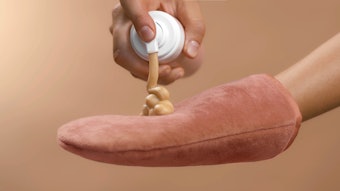
We all know sun protection is important, but there are still myths among consumers surrounding UV exposure and sunscreen usage. Below are seven myths that some clients believe, along with their truth. To help educate your clients on better UV protection, print out the infographic with this information below and hang it in you spa. Remember, sun protection does not stop at the end of summer.
Myth 1: The higher the SPF, the longer the protection
Truth: High SPF numbers lead to a false sense of security. SPFs higher than 50 provide 2% more protection than an SPF 25-30, which provides 97-98% protection against UVB rays. All sunscreens need to be applied every 90 minutes, especially if you are outside for more than two hours, actively playing sports, at the beach or gardening.
Myth 2. As long as you block UVB rays, which cause burning, you are safe.
Truth: You need broad spectrum sunscreen that protects against both UVA (aging) and UVB (burning) rays.
Myth 3. Sunscreen provides adequate protection.
Truth: You must take additional measure to adequately protect yourself in addition to sunscreen. Those include the following.
- Wear a hat with a wide brim.
- Apply a lip balm with an SPF of 15-30
- Wear clothing made of a protective fabric with a ultraviolet protection factor (UPF) of 15-50+.
- Avoid products and medications that make you more sensitive to sunburn.
- Take vitamin D supplements or eat food rich in the vitamin. This is safer than the sun.
- Stay out of the sun between 10 a.m. and 3 p.m.
Myth 4. Vitamin A should not be in a sun protection formula.
Truth: Ester forms of vitamin A and C such as retinyl palmitate or ascorbyl tetra isopalmitate are safe and actually photo-protective and do not create sun sensitivity.
Myth 5. A tan makes you look healthy.
Truth: A tan is a scar. Since ultraviolet light is a carcinogen, there is no safe amount of tanning. The risk of melanoma and other skin cancers increases with each tan.
Myth 6. Indoor tanning booths are a safer way to tan.
Truth. A study published in the Jounal of the American Academy of Dermatology, May 2014, demonstrated a significant increased risk of developing melanoma with exposure to 10 indoor tanning sessions.
Myth 7. You need both chemical and physical blockers to provide protection against UVA and UVB rays.
Truth. If 7-8% of broad spectrum blockers such as titanium dioxide or zinc oxide are in the product, they provide both UVA and UVB protection. In addition, a complex of antioxidant vitamins provide additional protection from free radical effects of sun's damaging rays. Unlike all the other chemical ingredients, which absorb the sun's rays and can cause skin sensitivity, titanium dioxide and zinc oxide reflect the UVA and UVB rays of the sun.











